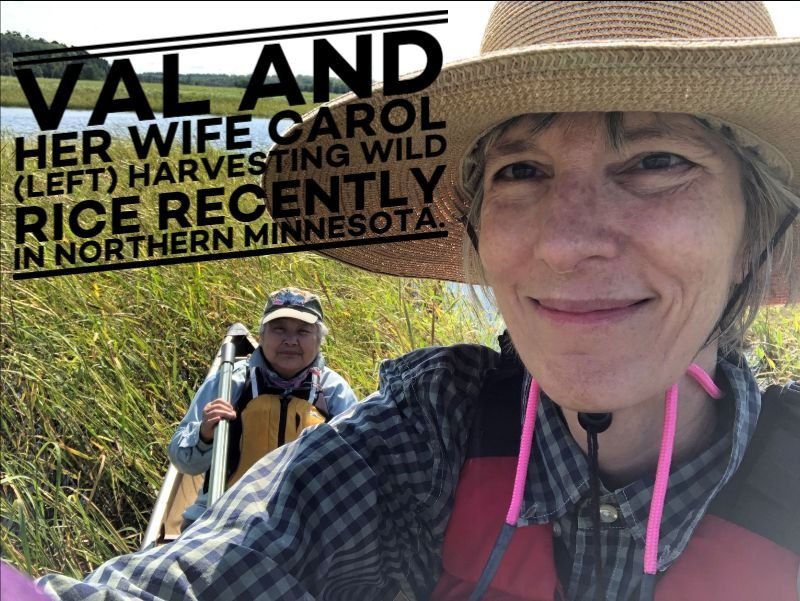From the Henhouse to Camas Friends
by Valerie Stoehr
When I was seven years old, a farmer who lived near our family home saw how much I loved chickens and gave me a cockerel—that’s a baby rooster—for a pet one summer. I named him Blackberry. We spent the days playing outside, often with Blackberry perched upon my head. Blackberry had glossy green-black feathers and beautiful eyes, and he taught me about how to communicate with chickens.
Before that summer I had begun lessons in chicken communication through spending time in my grandmother’s henhouse. If I sat quietly with the chickens, squatting between the nest boxes and the roosts, I could begin to feel part of the web of communication and energy within the flock. I watched the chickens relate to each other, and I listened to and sometimes mimicked their vocalizations.
Decades later, when I first began attending Quaker meetings, I thought about the lessons I learned from chickens. As about seven or eight of us gathered on Wednesday evenings for unprogrammed worship, I practiced feeling the same web of connection I had experienced in the henhouse.
And now, a few more decades after that first encounter with Friends, I’m thinking again about the chicken coop and the lessons I’m learning from Camas Friends.
My Path to Quakers
I left the Lutheran church in which I was raised when I was in my late teens. I left primarily for two reasons: first, I had come out as a lesbian, and I saw that my church did not fully accept LGBTQ people. Second, one of my best childhood friends was Jewish, and people of faiths other than Christianity stayed with our family as part of my mom’s work with international programs. As I saw it, Christianity implicitly demanded that non-Christian people become Christian, and I couldn’t reconcile that belief with my need for a universalist theology.
Seeing that I and others were unwelcome in the Church in which I was raised, I turned away from a community that had been a good and integral part of my childhood, where I was known and loved by an extended network of families and elders.
A bit more than a dozen years later, after the death of someone close to me, I felt the lack of being part of a religious community. I wanted to be with a community that grappled with the matters of life and death.
I knew I could not return to Lutheranism—Lutherans opposed ordaining LGBTQ people, and I did not want to be part of that institutional controversy. Yet I was clear about the value of staying close to my own religious tradition. Though I didn’t consider myself Christian, I wanted a spiritual practice that was rooted within Western Christianity. I was deeply involved in the church as a child, including sometimes playing the organ or piano for services. The music and stories of that tradition hold deep cultural and personal resonance for me. I wanted to work with their power and emotional hold on me.
Over the course of the next several years, I found and then became a member at an unprogrammed meeting in St. Paul, MN. I’ve been worshipping there, at Twin Cities Friends Meeting (Northern Yearly Meeting), for over twenty years.
A Spiritual Home with Shape-Note Singing
A few years after becoming a Quaker I learned about shape-note singing, and it has become a second spiritual home for me, as important to my spiritual identity as Quakerism.
Shape-note singing, which is sometimes called “sacred harp” singing, is an American singing and worship tradition. Its name comes from a system of shapes that were designed to teach uneducated people in colonial America how to read music and sing harmonies. The system for shape-note singing began in colonial New England and spread to the South, where it was preserved in isolated rural communities.
Shape-note singing is energetic and spirited. The harmonies are old and sound odd to modern ears. Its appeal is how it feels to sing it. Shape-note music is meant to be experienced, not sung for an audience.
The sacred texts that form the lyrics might be about death, crossing rivers, going to the land of Canaan, and how God’s soft hand shall wipe the tears from every weeping eye. I love the power of the strong metaphors and images, and I love the harmonies. I love how we minister to each other through the music. The experience is the same as the chicken coop for me, and the same as Quaker worship. We sing to experience the joy of singing with each other and with God, and we experience being knit together in love.
There is tension between my Quaker and shape-note identities. Sometimes I feel out of place with Quakers because I long for the energy and passion that I find in shape-note singing. And sometimes I feel out of place among shape-note singers because of my Quakerism. I like the tensions, though; they help me understand myself, and they strengthen my spiritual practice.
Finding Camas Friends Church
I’m especially interested in schisms within faith communities, and in November 2021 I attended a discussion via Zoom about recent divisions and difficulties in Quaker yearly meetings. The presentation focused on divisions over LGBTQ concerns, including within the Northwest Yearly Meeting of Friends.1
When co-presenter Jade (Souza) Rockwell spoke about Camas Friends, I realized that just a few days earlier I had coincidentally heard of Camas Friends. I was learning a shape-note song with text from the Book of Revelation and, in looking for related material, found a book about Revelation written by Wess Daniels, a former pastor of Camas Friends Church.2
“Interesting coincidences,” I thought to myself. “I should visit Camas Friends Church.”
I found the Camas Friends Church Zoom link for worship and joined their meeting for worship on the last Sunday in November 2021. It was my first experience attending a programmed Friends meeting.
An Unprogrammed Friend at Camas Friends Church
At my unprogrammed home meeting, Friends enter the meeting room silently, and it is not uncommon to sit in silence for the full one-hour meeting. When the period of expectant waiting ends, people greet each other, and the clerk and others deliver announcements.
In contrast, as we Zoomers gathered at Camas Friends Church, I watched Friends gather in groups and speak with each other. People embraced. A child skipped across the room to a pew.
Seeing Camas Friends gather reminded me of being in my friends’ synagogue before Rosh Hashanah or Yom Kippur services. As worshippers enter that synagogue they reach over and around each other to touch and embrace. Children might run down an aisle. People excitedly—loudly!—talk. It’s not the hushed scene from my Lutheran childhood, where we sat quietly in pews and listened to organ preludes. It’s dissimilar from my home meeting, where we do not speak to or touch each other when we enter the meeting room.
The service began with announcements. A worshipper then delivered prepared personal remarks (“First Word”) that established the theme for the day’s worship: Advent and waiting.
Music followed. I recall being surprised when the first song was followed by a second, and then further stunned when a third followed. The luxury of using three pieces of music in a row to drop us more deeply into worship? And an unhurried pace, and multiple verses for each song?
Next in the order of service was prayer. On that day, and on all subsequent Sundays when I worship, I heard deeply intimate requests for prayer. I’ve heard Camas Friends speak about the pain of knowing people on both sides of a war. About deep betrayals. About broken foster care systems. About seeking discernment for difficulty family relationships and situations.
Following the prayer requests, a prayer leader echoed back each request and knit them together into a collective prayer. It was my first experience seeing a prayer leader do this work.
I’ve seen prayer at Camas Friends Church take as long as thirty minutes, sometimes even longer. After especially intense prayer requests I’ve seen people in the meetinghouse move to sit next to and hold the hand of someone who delivered a difficult message. After a woman delivered an especially vulnerable prayer request, a man gently touched her arm in support as she returned to her pew. I’ve seen seamless partnership between us Zoomers and on-site worshippers. One day, after a particularly painful prayer request from someone at the meetinghouse, on-site Camas Friends gathered around a worshipper to lay hands upon her while someone on Zoom offered prayer.
A sermon followed the period of prayer, and then open worship. After the sermon, my experience is that worship is so ripe that riches of worship are ready to burst. Indeed, I remember vocal ministry from the first meeting I attended with Camas Friends. Several other potent ministries from the past several months continue to guide me.
What I Find with Camas Friends
I’ve come to know the circumstances of people’s lives intimately through what I hear each week in worship. I’m deeply moved by what we create with each other in worship. For me, the core of what happens at my unprogrammed meeting and what we do at Camas Friends Church feels identical and essential: we are working with each other to experience love with each other, and to practice how to do this with each other so that we can live in this way in all moments of our lives.
The forms of prayer, or music, or sermons—or the lack of them—are all tools in service of our work to experience communion with God. I’m back in the henhouse experiencing the connection that Camas Friends know how to create with each other, grateful to have stumbled into this community and the New Thing that Sierra-Cascades has created.
Valerie Stoehr (she/her) was raised in Minnesota, lived on the West Coast for a dozen years, and now lives in Afton, Minnesota. After earning a Women’s Studies degree she began a career in high tech, focusing on the design of digital products. She has been a member of Twin Cities Friends Meeting in St. Paul, Minnesota, since 2001, and has been attending Camas Friends Church via Zoom since the end of 2021. Val says the dynamics that shape her spirituality include living in Oakland, California, during the AIDS epidemic, and her connection to her German-American Lutheran grandmother, who farmed in rural Minnesota and lived to be 114 years old.
Footnotes:
1 The discussion was hosted by Earlham School of Religion. Angell, Stephen Ward, Charles Fager, and Jade Souza. Shattered by the Light, or, the Ruins & the Green: Quaker Churches in the Northwest and Midwest Clash and Divide over LGBTQ Issues. Durham, NC: Quaker Theology, 2021.
2 Daniels, C. Wess. Resisting Empire: The Book of Revelation as Resistance. Newberg, OR: Barclay Press, 2019.




